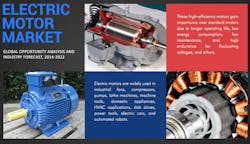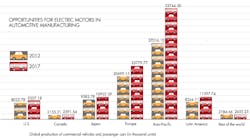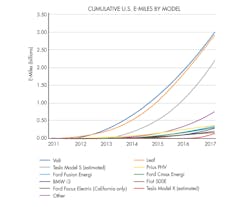Demand Soars for Environment-Friendly Electric Motors
Download this article in PDF format.
In the modern era, significant advances in technology have opened up opportunities to develop and manufacture electric motors for a wide range of applications in industries such as automotive, agriculture, construction, and other industrial sectors. Over the last two decades, greater importance placed on environmental safety has led to the drafting of several norms and regulations that specifically pinpoint this issue. Recently, advanced electric motors have found applications in robots and electric cars.
A recent report published by Allied Market Research focuses on the current trends, growth opportunities, and major challenges in the electric motors market. Further, it offers insights related to the industry, such as market share, size and growth. The report reveals that leading players in the field are shifting their attention to manufacturing energy-efficient electric motors.
A recent study from Allied Market Research depicts how electric motors will dominate the future market. The potential ranges in markets from industrial equipment like lathes and HVAC applications to even consumer goods like electric cars.
Electric Motors and Innovation
Electric motors have influenced the growth of numerous industries since their onset in 1834. Nowadays, electric motors are gradually replacing diesel and gas engines due to environment concerns. On top of that, they have demonstrated a longer operating life, consume less energy, and are easier to maintain than their standard engine counterparts, in addition to being well-equipped to tackle voltage problems. Electric motors are also replacing hydraulic cylinders.
According to James Kirtley, industry expert on electric motors and professor in the Department of Electric Engineering and Computer Science at MIT, around 40% of the total electric power is used to drive motors, and is set to continue at that level. Further, he adds that electric motors are widely used in airplanes, trains, ships, and cars. And, as mentioned, robots are another growth area for these motors.
The last decade has seen a shift from gas to electricity. Driving this transition is the need to develop energy-efficient devices that use clean sources of energy. Modern-day electric motors are versatile and adapt well to new applications in smaller devices.
Kirtley says that one size of motor is not suitable for all applications. The requirement and specifications of motors are constantly changing based on the type of application. Current electric motors are typically smaller in size and consume less power than their predecessors over the past 50 years. For instance, today’s automobiles incorporate around a dozen small electric motors for applications such as locks, air conditioning, wiper blades, and seat positioners.
Numerous innovative compact electric motors are designed and developed at the MIT, according to Kirtley. He and his research team at MIT are also working on innovative techniques to develop clean transportation. Recently, they partnered with a small firm in Cambridge that manufactures bicycle assist wheels. Energy stored in the wheels reacts to the pedaling forces that assist the bicycle to climb, say, a hill.
Efficiency of Electric Motors
The efficiency of a motor essentially boils down to the output and input power. Most electric motors are built to run at 50% to 100% rated load. Efficiency is the highest around 75%, and it tends to decrease around 50% load. Motor efficiency will vary based on the type of motor, though.
The graph highlights how many more opportunities have opened up for electric motors within the automotive industry in 2017 versus 2012. The data is from a 2015 study. (Courtesy of Global Industry Analysts Inc.)
When a motor becomes overloaded, it tends to overheat and, as a result, the overall efficiency takes a tremendous hit. Numerous motors are developed with a service factor that enables occasional overloading. The service factor is a multiplier that reveals how much a motor can overload under ambient conditions. Overall, energy-efficient motors consume less electricity, run under cooler conditions, and last longer.
In an electric motor, the efficiency is the ratio of the mechanical power delivered by the motor to the electrical power to the motor. To maintain a good efficiency ratio, such motors feature an enhanced design and utilize advanced quality materials to reduce motor losses.
Electric motors manufactured before 1975 were designed to meet the minimum performance levels. However, in 1977, the National Electrical Manufacturers Association (NEMA) suggested a process to tag the standard three-phase motors with an average nominal efficiency. Energy-efficient motors are marketed with the design standard NEMA-B speed-torque features. The efficiency of the motor depends on the construction materials and the mechanical design.
The operating and manufacturing costs of electric motors play an important role when it comes to the overall utility of the product. Operating hours, efficiency improvement values, and the load of a motor determine the operating costs.
Modern Applications and Innovation
Electric cars on the market has increased greatly since 2011 as more models like Tesla, Chevy Volt, and BMW i3 enter the market. (Courtesy of Plugless.com)
The arrival of robots and robotics in the last decade has significantly improved various aspects of different industries, particularly the manufacturing sector. Electric motors are playing an increasingly important role in this industry.
It is essential to have a smart motor in robots that can efficiently deliver different levels of power whenever required. Electric motors can also offer mobile robots a longer battery life compared to conventional hydraulic systems.
Over the last decade, an increase in customized applications has led to greater demand for customized electric motors. For example, Sangbae Kim recently designed a robotic cheetah that has recently gained a bit of notoriety. The motor used in the cheetah is energy-efficient and powerful at the same time.
Electric motors also enhance control and responsiveness. Kirtley mentions they can build a motor at MIT that produces torque in short spikes, even though they cannot produce the force for a prolonged period.
Conclusion
Application opportunities for electric motors have ramped up in the last 20 years across many industrial sectors. In turn, it has pushed market leaders to focus on manufacturing electric motors that are more energy-efficient and cleaner than other conventional motors.
Government initiatives have also offered a solid platform for industry players to develop electric motors without harming the environment. One example is an initiative taken by the Japanese government in 2010 to curb the harmful effects of electric motors in vehicles. Its objective was to boost the sales of vehicles that safeguard the environment and comply with the environmental safety regulations. Adoption rates of these motors are high in India, China, Brazil, the U.S., and Argentina in both the industrial and agricultural sectors.




